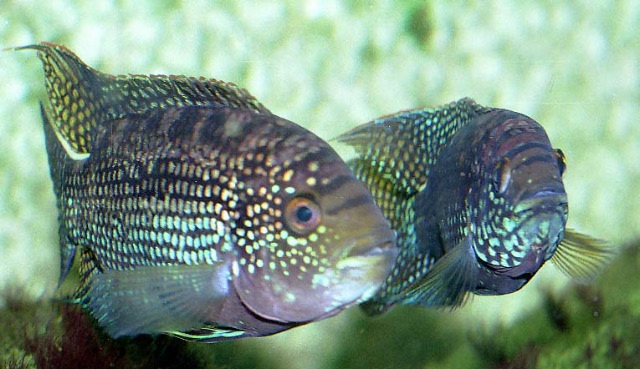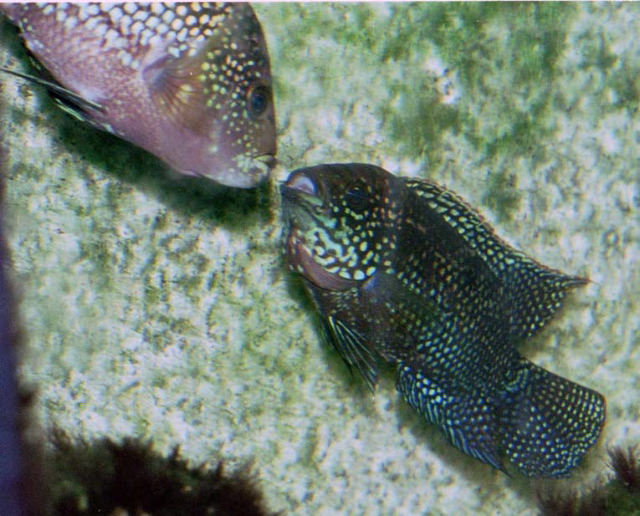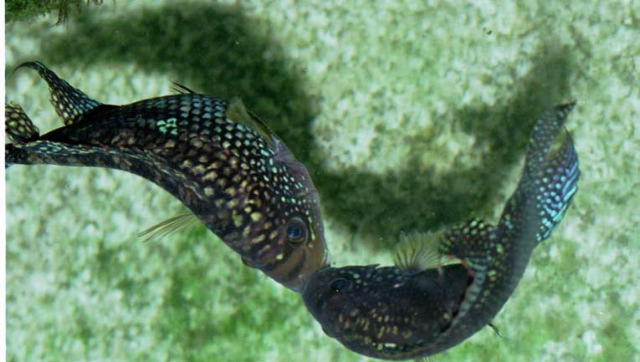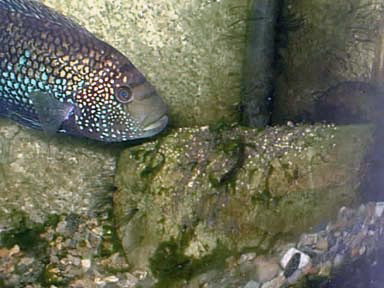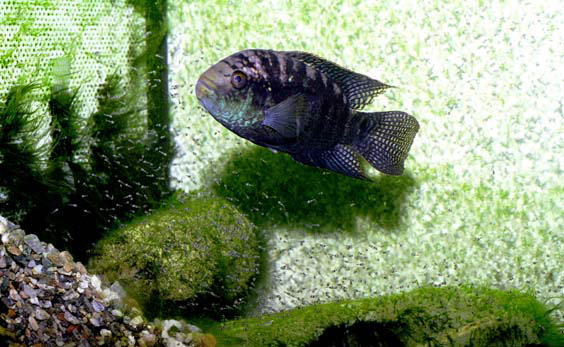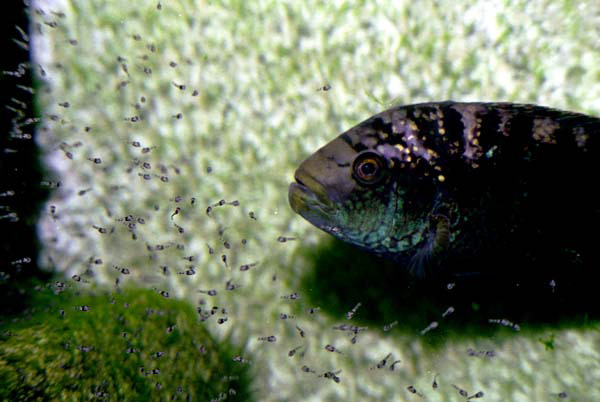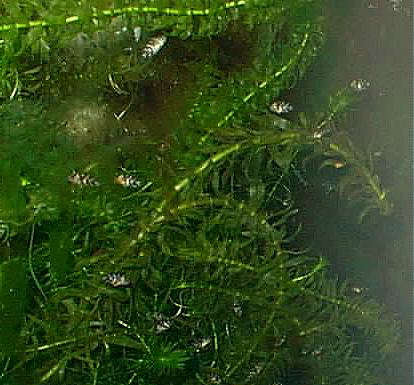

Name
Jack Dempsey
Cichlasoma octofasciatum
Also Known As
Cichlasoma biocellatum (with 2 spots, referring to 2 spots on side)
Cichlasoma hedricki
Cichlasoma nigrofasciatum
Heros octofasciatus
Source
Bogs and slow moving water - Guatemala, Yucatan, Honduras(3)
Water Requirements
Not sensitive. I have bred these fish in soft, slightly alkaline
tap water with no problems.
Temperature
Flexible in temperature, but breeds in the upper 70s. May not breed
at all below around 78 degrees. Will exist with no problems in a room
temperature tank.
Life Span
At least 10 years(1)
Size
Up to 8 inches.
Sex
Males are usually quite a bit larger than females and slightly more colorful,
with slightly longer fins. The fish in the above picture is a male,
but the females are very similar.
Feeding
Not picky, my fish ate primarily a variety of dry processed foods.
For some reason, they would not eat Hikara brand foods, though. I
have spiced up the diet with earthworms and the occasional ant or other
insect, in the summer months.
Color:
My fish would develop vertical stripes when guarding a spawn. Otherwise
they display a brilliant pattern of metallic colored spots.
Behavior (not breeding)
Male Jack Dempseys will not tolerate the presence of other male Jack
Dempseys. Once mature, I have only been able to keep one male per
tank. I expect you could keep a number together, if you had a large
enough tank to house them. On the other hand, despite the reputation
and the name, I found that my fish were very tolerant of other species
as long as they were introduced in the aquarium at the same time or before
the Jack Dempseys. For instance, Giant Danios make excellent tank
mates. When not defending a spawn or fry, I have found that Jack
Dempseys are shy, skittish fish. They would come out to eat, but general
hung out around whatever cover they could find. Except for their digging,
I have found that Jack Dempseys do not bother plants very much. Males
can be rough on females. I had to resort to using the disparity in
size to protect the females. I added a tank divider with a couple
of holes just large enough to allow the female to pass from side to side
at will. The larger male could not fit through the hole and was limited
to one side of the tank, where the female could join him, if she wished.
Breeding Behavior
These fish exhibit classic Cichlid open spawning behavior. I recommend
a temperate of around 78 degrees for spawning. They may not spawn at
lower temperatures. The males can be really tough on a female that is
not ready to spawn, to the point where he may kill her. Once a pair
reach spawning readiness, all other fish in the tank will be driven away
or destroyed. My Jack Dempseys have always cleaned an area on a rock
and spawned there. Mine would not spawn unless a suitable rock was
available. Spawn size is can be over 500 eggs and hatch in 3 days.
Once the spawn hatch, the parents move the fry to small holes dug into
the gravel. I eventually replaced the gravel I was using with sand
to allow a better substrate for keeping fry. Every day the fry are
moved to a new hole, until they become free swimming, which occurs in about
10 days. Parents share duties guarding the spawn and patrolling the
general area. It is interesting to watch how the fish exchange these
roles. They basically exchange spots in a swift motion, timed such
that the fish pass each other at the halfway point. A bit like a fishy
changing of the guard. Some sources say the young eat slime off the
sides of the parents, but I noticed very little of this sort of activity,
in my tanks. Though the fry may nip at their parents sides from time
to time, the fry are not dependent upon parental slime, like Discus are.
Parents will keep fry in a bunch by taking strays in their mouths and
returning them to the general school. Young may be able to stay
with the parents until the males begin to mature, at which point they will
need to be separated. It appears that the parents crush larger food
into small pieces and expel it through their gills for the young to consume.
Overall Recommendation
I kept these fish for several years. Because of males aggressiveness
during pre-spawning, it is hard to keep more than 1 fish per tank without
taking extreme measures, like the divider system mentioned in Loiselle's
book. I find it hard to understand why so many fish stores stock these
fish, which grow fairly large and can become aggressive in spawning and pre-spawning
situations. In my opinion, to keep more than one in a tank requires
special effort and attention. It may be possible to crowd a bunch
together, in which case the aggressiveness is split among a number of fish,
though I wouldn't recommend trying it. Keeping one in a community
tank is possible, but the introduction of new fish later on, could be risky.
References
1: Exotic Aquarium Fishes, Dr William T. Innes, I have 19th edition,
copyright 1966
2: The Cichlid Aquarium, Dr P.V. Loiselle, I have a copyright 1994 Tetra
Press edition
3: Aquarium Atlas, H. A. Baensch, Dr Rudiger Riehl
4: Handbook of Tropical Aquarium Fishes, Dr Herbert R. Axelrod, Dr. Leonard
P. Schultz, I have a 1971 edition.
Photo Gallery
